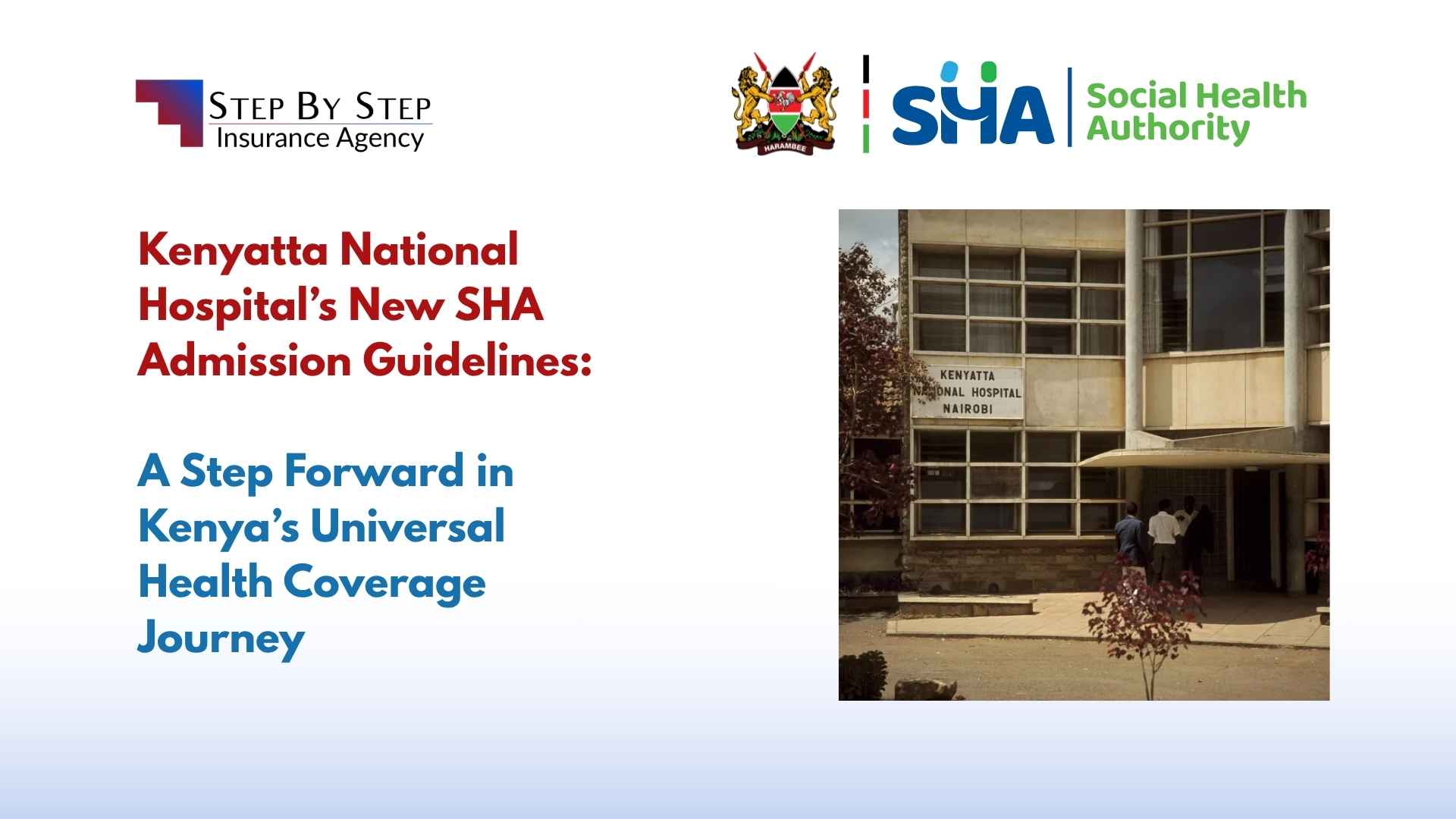Kenyatta National Hospital’s New SHA Admission Guidelines: A Step Forward in Kenya’s Universal Health Coverage Journey
New SHA Admission Guidelines at KNH: What Patients Need to Know
If you’ve visited Kenyatta National Hospital (KNH) lately or followed Kenya’s ongoing health reforms, you’ve probably heard about the new admission guidelines under the Social Health Authority (SHA). This isn’t just another bureaucratic update—it’s a pivotal moment in Kenya’s journey toward Universal Health Coverage (UHC). As SHA replaces the National Health Insurance Fund (NHIF), KNH, the country’s largest referral hospital, is taking the lead in rolling out protocols that could reshape how millions of Kenyans access inpatient care.
This article unpacks what these new guidelines mean for patients, providers, and the future of healthcare in Kenya. We’ll dive into the background of SHA, the specifics of KNH’s new rules, why they matter, and how they fit into the broader push for UHC.
Key Takeaways
- Mandatory SHA Registration: All patients must have a valid National ID linked to an active SHA membership for admission at KNH
- Pre-Admission Process: Patients must obtain a SHA reference number before hospital admission
- Digital Verification: SHA confirmation messages are now required for coverage eligibility
- Active SHIF Status: Inactive SHIF accounts will result in denied coverage
- New SHA Structure: SHA now manages three distinct funds covering different healthcare needs
Table of Contents
Join Our Insurance Community!
Connect with fellow Kenyans interested in insurance trends and get the latest news on SHA reforms
Join WhatsApp GroupBackground: The SHA and Universal Health Coverage in Kenya
The Shift from NHIF to SHA
Healthcare reform in Kenya has been a long time coming. For decades, the NHIF was the backbone of public health insurance. But as the country’s needs evolved, so did the realization that NHIF’s model—plagued by inefficiencies, fraud, and gaps in coverage—couldn’t keep up. Enter the Social Health Authority, or SHA, established under the Social Health Insurance Act of 2023. SHA is designed to be more robust, inclusive, and accountable, with the explicit goal of ensuring every Kenyan can access affordable, quality healthcare.
SHA isn’t just a rebrand. It’s a complete overhaul. The authority now manages three distinct funds:
Primary Healthcare Fund: For basic, community-level services
Social Health Insurance Fund (SHIF): The main pool for general outpatient and inpatient care, replacing NHIF
Emergency, Chronic, and Critical Illness Fund: For specialized, urgent, or prolonged care needs
SHA’s Role in UHC
Universal Health Coverage is about more than just insurance cards. It’s about making sure everyone, regardless of income or location, can get the care they need without financial ruin. SHA’s mandate is central to this vision. By digitizing processes, linking contributions to income (including for informal sector workers), and tightening eligibility checks, SHA aims to close the loopholes that left many Kenyans behind under NHIF.
The New Admission Guidelines at Kenyatta National Hospital
What’s Changed?
KNH’s new admission rules are clear, strict, and, for many, a wake-up call. Here’s what you need to know if you’re seeking inpatient care under SHA:
| Requirement | Description | Consequence if Missing |
|---|---|---|
| Valid National ID | Must be registered and linked to an active SHA membership | No admission under SHA |
| SHA Reference Number | Obtained before hospital admission | Admission not processed |
| Confirmation Message | Digital confirmation from SHA system | Ineligibility for coverage |
| Active SHIF Status | Verified active SHIF account | Denied SHA coverage |
The Process for Patients with Inactive SHIF Accounts
For those whose SHIF accounts are inactive at the time of admission, the process is straightforward but strict:
Activate your SHIF immediately
Return to the Health Information Desk for a new reference number
Only after this can you access SHA coverage, effective from the new reference date
KNH has made it clear: these aren’t suggestions—they’re requirements. Patients are urged to check their SHA and SHIF status before seeking care to avoid delays or unexpected out-of-pocket expenses.
Rationale Behind the New Guidelines
Why the sudden shift to such rigorous protocols? The answer lies in the challenges that plagued NHIF and the need to safeguard SHA from similar pitfalls.
Combating Administrative Gaps and Fraud
Under NHIF, administrative loopholes and lax verification led to widespread billing fraud and ghost claims. Unscrupulous actors could game the system, costing taxpayers billions and undermining trust. By requiring real-time verification, digital referencing, and active membership status, KNH and SHA are closing these gaps.
Ensuring Accountability and Tracking
The new guidelines ensure that every admission is properly tracked, referenced, and tied to a real, eligible patient. This not only protects SHA’s financial sustainability but also allows for better data collection, planning, and resource allocation.
Streamlining Claims and Reimbursements
For providers, the digital trail means faster, more accurate claims processing and reimbursement. No more chasing down paperwork or disputing eligibility after the fact.
Protecting the SHA Scheme
Ultimately, these measures are about making sure SHA can deliver on its promise: accessible, affordable healthcare for all Kenyans, without being bled dry by inefficiency or fraud.
Implications for Patients and Healthcare Providers
For Patients: Preparation is Key
If you’re a patient, the message is clear: prepare before you go. Here’s what you need to do:
Verify your SHA registration and SHIF status online or at your local health facility
Make sure your ID is up to date and linked to your SHA account
Obtain your reference number and confirmation message before heading to KNH
Failing to do so could mean delays, denial of care, or having to pay out of pocket—none of which anyone wants in a medical emergency.
For Healthcare Providers: Stricter Protocols
For hospitals and clinics, the new rules mean stricter admission protocols and enhanced verification processes. Staff must be trained to check digital references, verify IDs, and guide patients through the new system. While this may create bottlenecks initially, it’s expected to improve efficiency and accountability in the long run.
Challenges and Mitigation
Not everyone is tech-savvy or familiar with SHA’s digital processes. There’s a risk that vulnerable groups—elderly, rural, or less literate patients—could be left behind. To mitigate this, KNH and the Ministry of Health are ramping up patient education, community outreach, and support at health facilities.
Supporting Kenya’s Universal Health Coverage Goals
Equitable Access to Care
By tying SHA coverage to active membership and proper referencing, the new guidelines aim to ensure that only eligible, documented patients benefit from public funds. This is a cornerstone of UHC—making sure resources go to those who need them, not to fraudulent claims or administrative errors.
Enhancing Transparency and Trust
Transparency is key to building public trust in any insurance scheme. The digital, reference-based system means every admission is logged, every claim is traceable, and every shilling is accounted for. This is a far cry from the opaque, paper-based processes of the past.
Strengthening the Link Between Enrollment and Service Delivery
The new rules make it clear: enrolling in SHA and keeping your SHIF active isn’t just a bureaucratic box to tick—it’s your ticket to healthcare. This strengthens the link between insurance coverage and real-world service delivery, a critical step for UHC.
KNH as a Model for Other Facilities
As the country’s largest referral hospital, KNH’s successful implementation of SHA protocols sets the standard for other facilities nationwide. If KNH can make it work, smaller hospitals and clinics are more likely to follow suit, accelerating the nationwide rollout of UHC.
Broader Context: Healthcare Financing Reforms in Kenya
Recent Reforms and the Push for UHC
The new SHA guidelines at KNH are just one piece of a much larger puzzle. Kenya’s government has made UHC a central pillar of its development agenda, backed by legislative reforms, increased funding, and digital transformation.
Recent laws have:
Centralized health insurance under SHA
Mandated income-based contributions, including from the informal sector
Cracked down on fraudulent claims and unlicensed providers
Rolled out digital health platforms for registration, claims, and data management
The Role of Digital Systems
Digitalization is at the heart of these reforms. With the Health Information Exchange system and provider portals, Kenya is moving toward a future where health data is accessible, secure, and actionable. This not only streamlines care but also enables better planning and targeting of resources.
Addressing Persistent Challenges
Despite progress, challenges remain. Registration rates lag in some counties, and weekend uptake is low. The Ministry of Health is expanding community outreach and supporting facilities in transitioning from manual to digital systems. The goal is to leave no one behind, especially in hard-to-reach or underserved areas.
SHA Contact Information
Toll-Free Number: 0800 720 601
Email: customercare@sha.go.ke or info@sha.go.ke
Branch Locations:
- SHA Headquarters: Ground Floor, SHA Building, Ragati Road, Nairobi City
- KNH Hospital: Hospital Road, Nairobi
- Eastleigh: Sunrise Shopping Mall, Nairobi City
- Westlands: Rainbow Towers, Nairobi City
- Kangemi: Palace Building, Co-Op Bank, Nairobi City
- Buruburu: Mesora Centre, Nairobi City
- Gikomba: SK Plaza, Nairobi City
- Mama Lucy Kibaki Hospital: Spine Road, off Kangundo Rd, Nairobi City
- Industrial Area: Liberty Plaza, Opp Imara Junction, off Mombasa Rd, Nairobi City
- Ruaraka: ICPAK Building, Near KCA University, Nairobi City
- Kabarnet: Mart Properties Limited, Baringo
- Eldama Ravine: KCB Building 2nd Flr Mercy Hosp Rd, Baringo
- Sotik: Bureti Tea Growers SACCO Building, Bomet
- Bomet: Aggie Plaza, Bomet
- Bungoma: Daimah Plaza (Bungoma-Kanduyi Rd), Bungoma
Conclusion
Kenyatta National Hospital’s new SHA admission guidelines are more than just a policy update—they’re a bold step toward a future where every Kenyan can access quality, affordable healthcare without fear of financial ruin. By insisting on active membership, digital referencing, and strict eligibility checks, KNH and SHA are laying the groundwork for a more accountable, efficient, and equitable health system.
For patients, the message is clear: check your SHA and SHIF status, get your reference number, and be prepared before you seek care. For providers, it’s time to embrace stricter protocols and digital systems. And for policymakers, the lesson is that real progress on UHC requires not just bold vision but also practical, on-the-ground changes.
As Kenya continues its journey toward Universal Health Coverage, the experience at KNH will be watched closely. If these reforms succeed, they could become a blueprint for hospitals and health systems across the continent.
So, whether you’re a patient, a provider, or just a concerned citizen, now’s the time to get informed, get involved, and help shape the future of healthcare in Kenya.
Related Articles
Comprehensive Guide to SHA Packages
Everything you need to know about the different SHA packages available in Kenya and how to choose the right one for your needs.
Read ArticleSHA Payment Options Update
Learn about SHA’s new payment plans including the flexible Lipa SHA Pole Pole Plan designed for informal sector workers.
Read ArticleSHIF Registration Guide
Step-by-step instructions on how to register for SHIF and secure your health coverage under Kenya’s new insurance system.
Read ArticleTaifa Care Enrollment Milestone
Latest statistics on SHA’s enrollment success with 24 million Kenyans now covered under the Taifa Care program.
Read ArticleExternal Resources
Official SHA Website
Visit the official Social Health Authority website for the latest updates, forms, and official information.
Visit Website





